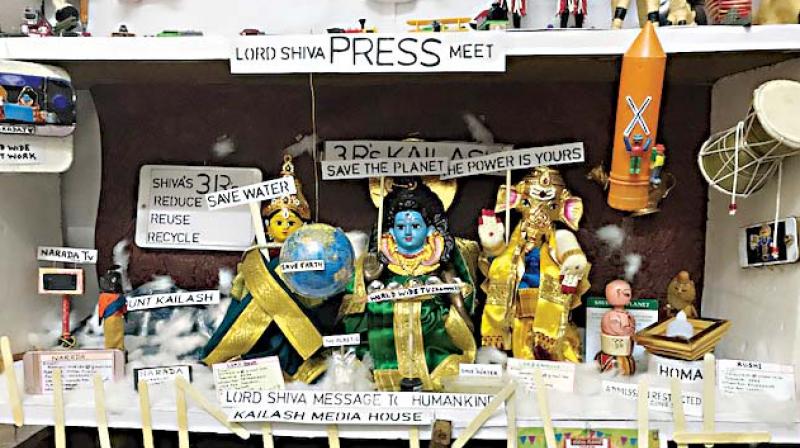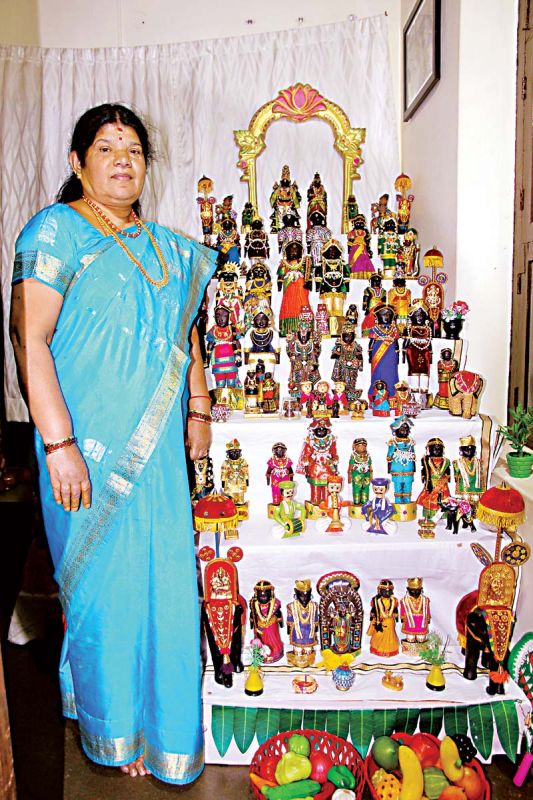A Doll's House: Iyer's gombes date back 300 years

Navaratri is the most festive time of year, a symbol of good triumphing over evil. Dasara, as this ten-day period is called, traces its earliest roots in Karnataka to the Vijayanagar dynasty. Mahanavami, as it was known then, is depicted on relief artwork in Hampi. The Wodeyar kings brought new meaning to the festival, infusing it with societal harmony and the Naadu Habba was the day when the king made his much-awaited tour of his kingdom. The gombe tradition has its origins here, when subjects made replicas of their beloved monarchs, says Regret Iyer, whose home contains 3000 gombes, some over three centuries old. Tracing his traditions back to the 17th century, Iyer tells Darshana Ramdev the story of Dasara and how it became what it is today.
Technology holds us together today, giving the common man direct access to his leaders and turning the hierarchy on its head. With the media acting as a relentless watchdog, very few discrepancies from the political class escape public notice. Back in the 17th century, however, when the Mysore Dasara festival first began in 1610, this was not the case. Here, societies were bound by reverence for their kings, who were usually likened to God on earth. The king represented safety, security and well-being. Still, generations could live and die without ever setting eyes on their beloved monarchs.
The Iyer home in Thyaga—rajanagar still bears traces of this history. This year, in fact, the Iyer family has recreated Mysore Dasara celebrations from 1610 to the present day. 30 versions of the habba have found expression in the Iyer home, lined up in steps. Their collection of 3000-odd gombes, or dolls, is Vijayalakshmi Iyer’s pride and joy and the month leading up to Dasara is a very happy time indeed. “Our family can trace its roots back 356 years and this is the 318th year we’re celebrating the gombe festival,” says Regret Iyer, as he and wife spoke to Deccan Chronicle.
 Vijayalakshmi Iyer with her gombe.
Vijayalakshmi Iyer with her gombe.
The family traces its origins back to the 17th century, to Kothmangala village in Karnataka. The first generation Iyer, Narasimha, was the village headman. The Dasara festival had evolved, by this time, after the disintegration of the Vijayanagara dynasty, into a celebration of the monarchs themselves. “People used to make elaborate sets, with dolls representing the king and queen, as a mark of respect,” says Iyer. The festival was celebrated first in the palace, after which the king would be brought outdoors, in a procession, to survey his kingdom. “People didn’t often see their kings,” she says. “This also gave form to the devotion.” The collection of gombes was eventually passed on to Regret Iyer’s father, S.N. Iyer and was transferred to storage. “We rekindled the tradition only after I met my wife, who was determined that the dolls shouldn’t be neglected,” he says.
Much has changed since. Today, the Mysore Dasara marks the day when Goddess Chamundeshwari (Durga) killed the demon Mahishasura. “It is no longer about the king and his subjects but back then, the king was likened to God. He was the people’s saviour and benefactor on earth – that was the role of the king in society,” says Iyer, who recalls going to Mysuru back when he was in his early 20s.
Having grown up with tales of pomp and glory around the Palace, Iyer wanted to take a look for himself. “I was quite nervous because I didn’t know anyone in Mysore,” he laughs. He did, however, make the trip and stood patiently in line until he was brought face-to-face with Jayachamarajendra Wodeyar. “We see photographs and hear stories but nothing compares to the real thing,” he says.
Back in the 17th century, however, the Dasara festival, which was re-introduced by Raja Wadiyar, who stepped in to fill the vacuum after the disintegration of the Vijayanagara empire. The gombe tradition began during this time, says Iyer. Navaratri became a time of gratitude and obeisance to the monarch and crossed the boundaries of caste, communities, even religion. “The festival changed with each king.”
The gombes themselves began with villagers dipping their hands in mud to fashion human figures from the clay. Sandalwood and rosewood became common materials later. Now, they’r emade from steel, gold, silver and porcelain, all of which have representation in Iyer’s extensive collection. Spread out across three rooms in the house, some of the dolls are as old as 318 years old and highglight this year, says Iyer, are the wooden dolls. “They were appreciated because they were portable and sturdy,” he explains.
Stories have always been part of the gombe tradition and the epics are retold in countless ways. A replica of the Singapore Bird Park is one of their most treasured displays this year and came of a visit the couple made to that country.
“I took photographs of the architecture to recreate here,” says Iyer, who remarks that now, holidays with his wife are a sort of scouting expedition. Anything that catches their eye is likely to make it back to their gombe displays that year!
Vijayalakshmi’s preparations begin 10 days before the festival. The dolls need to be brought out, cleaned, arranged and dressed. Clothes and faux jewellery are also used. There’s another display, however, of which Iyer is visibly proud. “I am a journalist,” he says, by way of explanation. In this display, which is a comment on climate change and the need to save our ecosystem, Shiva, Parvati and Ganesha hold a press conference to discuss the matter. “Narada is the reporter,” Iyer chuckles. “It’s important to give a message and kids are so fascinated by these dolls. It is a platform for us to pass on the wisdom and traditions of our forefathers to our children.”
B02

